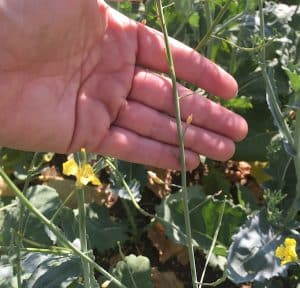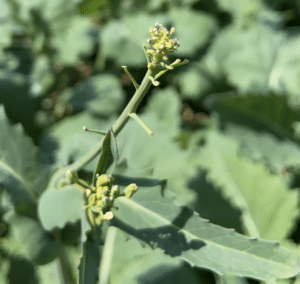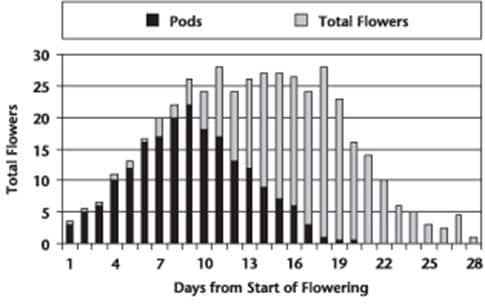Are canola plants missing pods? Many things can cause disruptions and malfunctions in bud formation and pollination that lead to blanks on canola stems where pods should be.

Weather
Heat
Hot days (28-30°C and up) from bud to mid-flowering stages can have a significant effect on canola yield. It reduces flower reproductive function, which results in blanks along the stem. Even with a few days of heat, it can take a week for hormone balance and regular pod formation to return. Most years, seeding early so canola flowers during cooler parts of the summer is an effective strategy for higher yields. Recently opened flowers with shortened stamens that don’t protrude above the petals can be a sign of heat damage. Heat at flowering, Canola Encyclopedia. Treatment.
Drought
Moisture stress during reproductive stages can cause a hormone imbalance that disrupts pod formation and seed set. In a drought, canola plants will progressively drop later flowers at the top of the main raceme and on branches, and put energy into preserving the pods it has. In late season drought during pod fill, seeds that do form may germinate in the pod due to the hormone imbalance. If moisture returns, plants can start preserving flowers again, resulting in a stem with pods at the bottom and top but nothing in the middle. Additional symptoms of drought include leaf wilting, and flowers with smaller petals that may be off-colour (pale or yellowish-orange), or flower buds that die before fully opening.
Heavy rain or wind
Heavy rain could reduce pollination in recently opened flowers and cause fewer seeds per pod in those flowers.
High winds can blow off flowers. At earlier stages, high wind can also damage the bolting stem and produce effects that linger into flowering.
Plant not seriously harmed by strong winds or rain can compensate to produce more flowers. If crop is at less than 50 per cent flower, it will continue to utilize new blooms to replace potential lost pods. If beyond 50 per cent flower, more of the crop yield potential is already set, so crop plasticity is starting to decline. See the graphic at the bottom of the article.
Hormone imbalance
Any weather stress can trigger a hormone imbalance that leads to malformed growing points, abnormal bud and flower production, and sterile pods. Symptoms include thin, sometimes crooked growth on the first raceme (main stem). Racemes that should be producing flowers and pods are delayed, with odd growth patterns around buds. The “mystery syndrome” or “floral deformation syndrome,” often found in weather-stressed canola, is very likely the result of hormone imbalance.

Nutrient deficiency
Sulphur
Canola plants short of sulphur can have reduced pod and seed set. Look for stunted growth, light-coloured leaves on newer leaves vs older leaves, purpling and cupping on stem leaves during bolting, and pale, smaller flower petals, especially on hill tops where sulphur deficiency tends to be more common. Stamens will protrude normally on sulphur deficient plants. Sulphur deficiency symptoms. Tips to apply sulphur in season.
Boron
Boron deficiency can reduce fertilization, leaving blanks up the stem. Plants with boron deficiency will often flower longer to compensate for poor seed set or may not flower at all, and may have leaf blotches ranging from pale yellow to reddish purple. Boron deficiency symptoms will show up in the younger leaves and growing points because boron is not mobile in the plant. Boron deficiency tends to be location specific, with only patches of the field (usually sandy areas) showing blanks. The challenge with boron is that application studies on the Prairies have not shown significant or reliable results. Boron, including symptoms and application tips, in Canola Encyclopedia.
Pest damage
Insects
Lygus bugs and diamondback moth larvae feed on buds, killing them. They may only kill a few buds per cluster, so the plant produces pods here and there up the stem. Dark stains on flower petals and shriveled brown pedicels are signs of insect feeding on buds. (Pedicels will be intact after heat or drought damage.) Swede midge also damage flowers and bud clusters, resulting in missing pods and densely clustered pods on shortened racemes – a “bouquet” or “witch’s broom” appearance. At flowering, a canola plant’s response to the first bit of insect damage is to produce more flowers and try to set more seed. In this situation, plants can even “overcompensate” for a small amount of insect feeding with increased yield. Insecticides are not always required.
Aster yellows
Aster yellows is a phytoplasma infection that can cause symptoms ranging from discoloured or disfigured leaves to pod abortion, misshapen pods and flower buds. Most fields in most years have less than one per cent infection, which is not an economic level of loss. If you are seeing unexplained growth, please contact a CCC agronomy specialist.
Management issues
Herbicide damage
Late off-label applications of herbicides and spray tank residues or drift can damage buds and flowers, resulting in blanks. For example, glyphosate applied after the six-leaf stage on Genuity Roundup Ready canola may result in pale petals of normal size and short stamens that don’t protrude above petals in recently opened flowers. Reductions in yield can also occur because of the energy trade off of metabolizing a late application. There can be significant pod sterility and blanks as a result. Higher rates than allowed on the label can also increase the yield loss. Look at sprayer misses or overlaps for differences to confirm this diagnosis.
Male sterility
The F2 generation (volunteer plants) will have the maximum amount of variability, resulting in up to 25 per cent sterility. A very small percentage of plants in hybrid canola may be male sterile as it’s difficult with any system to have 100 per cent hybridity. Male sterile plants require cross pollination from neighbouring pollen-producing plants, and as a result will produce fewer pods and many blanks. Male sterile plants often tend to stick up above the rest and are scattered throughout the field at low numbers. This can make the situation look worse than it really is. Male flowers will not have evident stamens on recently opened flowers.
Combinations
Poor or restricted root growth
Root issues that disrupt normal plant growth may manifest as missing or poor pod development. These can include clubroot, foot rot, root maggot, compaction that causes shallow rooting, and acid soils causing root pruning with aluminum toxicity.
Canola can compensate for lost flowers
Canola can lose flowers to many stresses, including insects, heat, heavy rain, and late herbicide application. Plants that lose flowers can recover without a yield penalty – or not much of one – if conditions improve by early to mid flower. The chart above shows that canola plants produce far more flowers than pods, providing a cushion to compensate for flower loss early. The plant can utilize the later flowers if needed. If not needed, these late flowers won’t likely amount to much.

